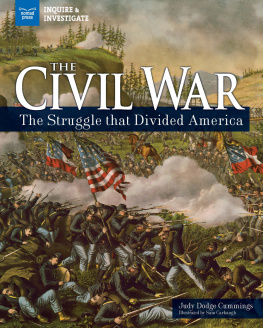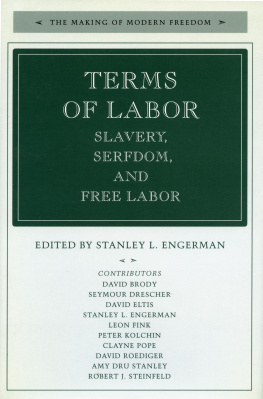freedoms frontier
2013 THE UNIVERSITY OF NORTH CAROLINA PRESS
All rights reserved
Designed by Sally Scruggs
Set in Quadraat by codeMantra
Manufactured in the United States of America
The paper in this book meets the guidelines for permanence and durability of the Committee on Production Guidelines for Book Longevity of the Council on Library Resources.
The University of North Carolina Press has been a member of the Green Press Initiative since 2003.
Library of Congress Cataloging-in-Publication Data
Smith, Stacey L. Freedoms frontier : California and the struggle over unfree labor, emancipation, and reconstruction / Stacey L. Smith.
pages cm
Includes bibliographical references and index.
ISBN 978-1-4696-0768-9 (cloth : alk. paper)
ISBN 978-1-4696-2653-6 (pbk. : alk. paper)
1. Forced laborCaliforniaHistory19th century. 2. Slave labor CaliforniaHistory19th century. 3. CaliforniaSocial conditions 19th century. 4. CaliforniaEconomic conditions19th century. 5. SlaveryCaliforniaHistory19th century. 6. LaborCaliforniaHistory 19th century. 7. CaliforniaGold discoveriesSocial aspects. I. Title.
HD4875.U5S525 2013
331.11730979409034dc23
2013001365
Portions of this work appeared earlier, in somewhat different form, as Remaking Slavery in a Free State: Masters and Slaves in Gold Rush California, Pacific Historical Review 80, no. 1 (February 2011): 2863. 2011 by the Pacific Coast Branch, American Historical Association, and the Regents of the University of California.
for David
Contents
CHAPTER 3 Hired Serfs and Contract Slaves
Peonage, Coolieism, and the Struggle over Foreign Miners
CHAPTER 4 Enslaved Wards and Captive Apprentices
Controlling and Contesting Childrens Labor in 1850s California
CHAPTER 5 For Purposes of Labor and of Lust
Californias Traffics in Women
CHAPTER 6 Emancipating California
Californias Unfree Labor Systems in the Crucible of the Civil War
Illustrations and Tables
Illustrations
Tables
Acknowledgments
Writing a book can often be a solitary venture. I am fortunate, however, to have had the support and encouragement of many people, who have made the research and writing process far less lonely and far more rewarding than I would have ever imagined.
My greatest debts, intellectual and personal, are to Susan Lee Johnson. I first met Susan when I was an undergraduate at the University of ColoradoBoulder. In a serendipitous turn of events, she ended up taking a job at the University of WisconsinMadison shortly after I began my graduate career there. I am thankful every day for the twist of fate that caused our paths to cross again. Susan read earlier versions of this work over and over again, always with an eye for detail and story, and always with excellent advice, encouragement, and praise. Susan is a dogged researcher, a fantastic writer, a generous scholar, an amazing editor, and a dedicated teacher. Her guidance over the past decade has made me a better writer and a better historian. I could not have asked for a more engaged and helpful mentor.
I owe a great deal to several other Wisconsin faculty who have shaped this project along the way. My earliest graduate adviser, Stephen Kantrowitz, guided me through my first years of the program. His unfailing faith in my abilities, his spirit and smarts, and his boundless enthusiasm for history helped me make it through those first angst-filled years of graduate school. Whenever my confidence faltered, Steve was always there to remind me of the significance of this project and the important work yet to be done. Bill Cronon, Arthur McEvoy, and Ned Blackhawk also played critical roles in shaping this text. Bill is a model of how to be a generous and engaged scholar and teacher, and I am indebted to him for all the time he has invested in my career. Art has been of invaluable help in teaching me to navigate the treacherous waters of U.S. legal history. Neds teaching and scholarship have greatly enhanced my understanding of the history of North American indigenous peoples, and he has been a great influence on this work.
As an undergraduate and later as a graduate student, I have been fortunate to work with many other wonderful scholars, teachers, and fellow students. I am grateful to Fred Anderson, Virginia Anderson, Julie Greene, and Martha Hanna at the University of ColoradoBoulder for encouraging me to go on to graduate school and for keeping in touch with me long after. At Wisconsin, I had the good fortune to work with the late Jeanne Boydston, as well as with Cindy I-Fen Cheng, Colleen Dunlavy, Florencia Mallon, Tony Michels, Francisco Scarano, and Steve Stern. A number of gifted fellow graduate students also helped my career, and this book, come to fruition. Many thanks to Catherine Burns, Sarah Costello, Suzanne Danks, Jerome Dotson, Jim Feldman, Mark Goldberg, Kori Graves, Rob Harper, Michel Hogue, Jennifer Holland, Sarah King, Abigail Markwyn, Gladys McCormick, Michelle Morgan, Haley Pollack, Gil Ribak, Kelly Roark, Kendra Smith-Howard, and Tyina Steptoe for support, friendship, food, and fun over these many years.
My colleagues at Oregon State University, where I arrived in 2008, have aided immensely in the production of this book. As chairs of the History Department, Paul Farber, Jonathan Katz, David Luft, and Ben Mutschler guided me through the hiring and tenure process and made sure I had time and resources to complete the book manuscript. Very special thanks go to Jeffrey Sklansky for his enthusiastic support of my research and the many hours he spent helping to get me settled in at Oregon State. Fellow Americanists Mina Carson, Marisa Chappell, and Christopher Nichols and fellow western historian Bill Robbins have been generous with their time and help. I have also benefited from many conversations with colleagues in other fields, including Gary Ferngren, Anita Guerrini, Jake Hamblin, Bill Husband, Hung-Yok Ip, Paul Kopperman, Bob Nye, Mary Jo Nye, Mike Osborne, Stephen Rubert, Lisa Sarasohn, and Nicole von Germeten.
Beyond my own institution, I have been fortunate to receive help from many generous and talented scholars. Michael Magliari has shared his scholarship on Indian slavery with me, commented on the entire book manuscript, and helped me to tackle the vast California manuscript collections at the Huntington Library. He has my eternal thanks for his generous spirit and for his help correcting many mistakes. Thanks, too, to the editors of the Pacific Historical Review, Carl Abott, David Johnson, and Susan Wladaver-Morgan, as well as to Amy S. Greenberg and several anonymous readers who helped me develop an earlier article related to this book. Thanks also to Stephen Aron, Alicia Chvez, Lauren Cole, William Deverell, Robert Dykstra, Joseph Genetin-Pilawa, Deena Gonzlez, Kelly Sisson Lessens, Joshua Paddison, Heather Cox Richardson, Steven Rosales, Allison Tirres, and Richard White for reading and commenting on portions of this work at various conferences and workshops over the years.
A number of institutions also made my writing and research possible. Funding from the Horning Endowment and the Center for the Humanities at Oregon State University provided me with much-needed leave time to finish the book revisions. As a graduate student, I also benefited from funding by the Doris G. Quinn Dissertation Fellowship, sponsored by the University of WisconsinMadison Department of History and the Doris G. Quinn Foundation, as well as the Dana-Allen Dissertator Fellowship at the University of WisconsinMadison Institute for Research in the Humanities and the American Historical Associations Albert J. Beveridge Grant. The Western History AssociationHuntington Library Martin Ridge Fellowship and the Annaley Naegle Redd Award in Western Womens History from the Charles Redd Center for Western Studies at Brigham Young University allowed me to travel to crucial archives.
Next page









